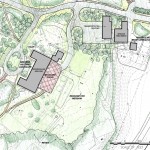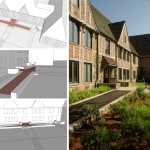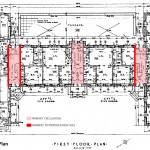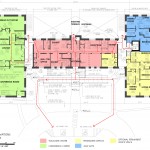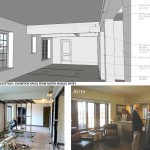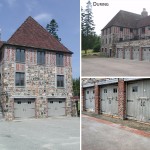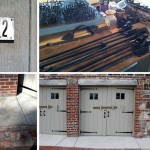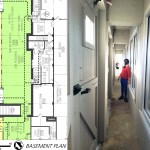Rockefeller Hall, Acadia National Park, National Park Service
Project Name: Rockefeller Hall, Acadia National Park, National Park Service
Rockefeller Hall (1) is one of Acadia National Park’s most significant historic buildings. Sited prominently at the entry (2) to the former Navy base at WinterHarbor, Rockefeller Hall was built in 1933-1934 as a three-story apartment building for Navy personnel. John D. Rockefeller, Jr. commissioned noted New York architect Grosvenor Atterbury, who designed this eclectic masonry veneer/half-timber facade over a modern steel/concrete framed structure. By contrast, the interior was in keeping with Atterbury’s 1930s apartment buildings of the time: simple details, plaster walls, wood floors.
Essentially untouched for over 80 years, Rockefeller Hall continued to serve its original use until the National Park Service (NPS) partnered with tenant Schoodic Educational Research Center (SERC) for repurposed compatible use as on-site accommodations, ConferenceCenter and WelcomeCenter.
Major design challenge: accessibility to and through the building. The grade change required a ramp to one of the main entrances, with a strong Owner’s desire to enter the building centrally. Our solution (3) sensitively negotiated this goal, retaining most of the original material. Entrance landings (4) were reconstructed reusing original material in exacting recreation, modifying only the center landing for the ramps.
Major preservation challenge: integrate the new use with minimal disruption to the historic floor plan (5). The plan was segmented in non-communicating major blocks. There was no circulation cross-axially. We resolved the challenge with discreet openings (6) providing full access.
Function challenge: open up small rooms to provide one larger reception area, an issue strongly contested in Historic Preservation review. Rather than completely obliterating the historic plan we selectively removed walls, leaving the upper portion of walls as “ghost walls” (7) allowing future historians to read the evolution of the plan.
Code railing upgrades (8) retained the original materials with new respectful alterations.
Terrace (9) underwent years of inappropriate replacement/repairs. We replaced the terrace with a new raised system most reminiscent of the original scored concrete deck.
Garage doors (10), a major character-defining element, presented a challenge to re-purposing the basement. A new glass/aluminum envelop wall is set behind the historic doors to allow full use of the basement meeting space in conditioned space.
Inherently sustainable as an adaptive use in a durable, long life-cycle building we improved the metrics by providing:
- New high efficiency mechanical system
- Water saving plumbing fixtures
- New electrical service and efficient lighting
- Commissioning


